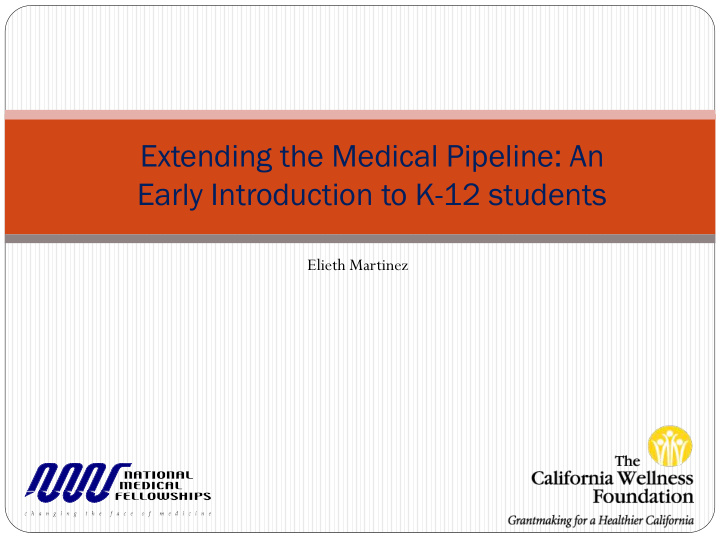



Extending the Medical Pipeline: An Early Introduction to K-12 students Elieth Martinez
Background “ We conclude that, in the field of public education, the doctrine of ‘separate but equal’ has no place. Separate educational facilities are inherently unequal” – United States Supreme Court My objectives: - To return to my middle school, Monroe Middle School, to empower students -To serve my community as an advocate for higher education -To serve as a role model for future first-generation to college students -To spark an interest in health care careers among students with low HS graduation rates
Background • Nationwide efforts including the Patient Protection and Affordable Care Act are in place to address health disparities by increasing the insured, however, such efforts will increase demand for the number of physicians caring for low-income, Medicaid-qualifying patient. • Considering that black and Hispanic physicians disproportionately care for more minority patients, uninsured, and Medicaid patients than their white colleagues, increasing the number of minorities enrolled in medical school is imperative • Seventy-six percent of Hispanic students and 68 percent of African-American students graduate from high school. Those rates are about 10 to 15 percent less than the graduation rate of white students • Students who do not complete high school are ineligible to attend four-year institution, therefore, decreasing the numbers applying to college and graduate school, specifically medical school.
Objective • Increase and evaluate interest in a health professional careers including medicine using organ modules, workshops, and mentorship • Evaluate and increase higher education knowledge by using workshops on Scholarships, Mentorship, Colleges • Initiate community partnership between middle school and pre-med and medical students from racial and ethnic background to build trusting mentorship relationship
Results Approximately 120 middle school and high school students participated in the program. • 19% of students were English learners, • 94% were eligible for free/reduced priced lunch, and • 11% had special education within the past two years. • Parent demographic included: 40% of parents did not graduate from high school, 33% had a high school education, and 20% had some college. • The student racial and ethnic composition consist of 67% Hispanic/Latino and 31% African American. • Approximately 90% of students had never set foot in a college campus including community college and four year education.
Results • Approximately 80% of the students would be the first in their family to attend college and a similar percentage did not know anyone who has ever attended college. • None of the students have ever encountered a health professional outside of a doctor’s visit. • Compared to pre and post survey, there was a 45% increase in interest in the fields of medicine, nursing, and teaching. There was a 60% increase in content knowledge on cardiac and pulmonary anatomy and physiology. • Compared to pre and post survey, 80% of students understood different educational tracks to get to enter the medical field including four year colleges, Cal State colleges, and community colleges.
Conclusion • By increasing early exposure and intervention for at risk students attending low income schools in urban underserved areas, the proportion of college graduates will increase and therefore increase the percentage of minority students applying to medical school • Increasing the pool of qualified applicants can only be achieved with supporting mentorship and early outreach programs during primary and secondary education • Without addressing disparities in education, health disparities will continue to persist
Student Reflections “I was already interested in sciences and medicine, but now I find it to be even more fascinating” “I am grateful for their visit and would hope we could have more like them in the future” “To me, it was a learning experience, and makes me have thoughts about becoming a doctor or something in the field” “I learned how to do CPR and save someone’s life, it was a great experience” “I personally found their lessons to be intriguing and inspiring. It made me consider actually going to medical school”
Acknowledgements Funders National Medical Fellowships The California Wellness Foundation Schools Monroe Middle School View Park Preparatory High School Volunteers Guadalupe Gomez, Centers for Disease Control Employee and Monroe Middle School Alumni Ronald Gomez, Teacher with LAUSD and Monroe Middle School Alumni Lydiesther Martinez, Medical Student at University of Illinois Chicago and Monroe Middle School Alumni Ali Saadi, Medical Student at UC San Francisco
Recommend
More recommend